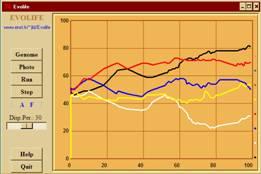
- Overall description
- How to execute Evolife (+ download)
- Evolife source files
- Evolife classes and functions
- How Evolife works
- Create your own Evolife scenario
- Use Evolife’s components separately (graphics, ecology, genetic algorithm)
4. Evolife Classes
The first module is centred on EvolifeIndividual. An Individual inherits its genes from Genome. Note that genes (defined in Genome) are logical segments located on the DNA. Therefore Genome inherits from DNA. Individuals have also a phenotype, defined in Phenome. An individual remembers its social links, which are stored in Alliances. EvolifeIndividuals gather in groups (class EvolifeGroup), in which they interact and reproduce. Individuals may move from group to group. EvolifePopulation defines a set of groups.Storage, Base_Examiner, Examiner and Meta_Examiner are used to store numbers (simulation results) and perform statistics. Evolife_Observer is aware of the kind of data that are processed (genomes, scores, ...).Any particular scenario should inherit from Default_Scenario (as indicated for Void_Scenario in the figure). Besides particular functions defined in the scenario, Default_Scenario provides access to simulation parameters (through inheritance from Parameters) and to the logical definition of genes on the DNA string (through inheritance from Genetic_Map).The following figure describes the organization of the graphic modules.
In the logic of QT, areas (QT’s scenes) require a view to be displayed. This is the role of the widget AreaView and its descendents. Active_Frame adds keyboard shortcuts, so that the same keyboard actions will be available from any Satellite_window (windows that display genomes, trajectories, field, ...).The next figure illustrates the organization of the control windows, which constitutes the fifth and last module (the new classes are defined in Evolife_Window.py).